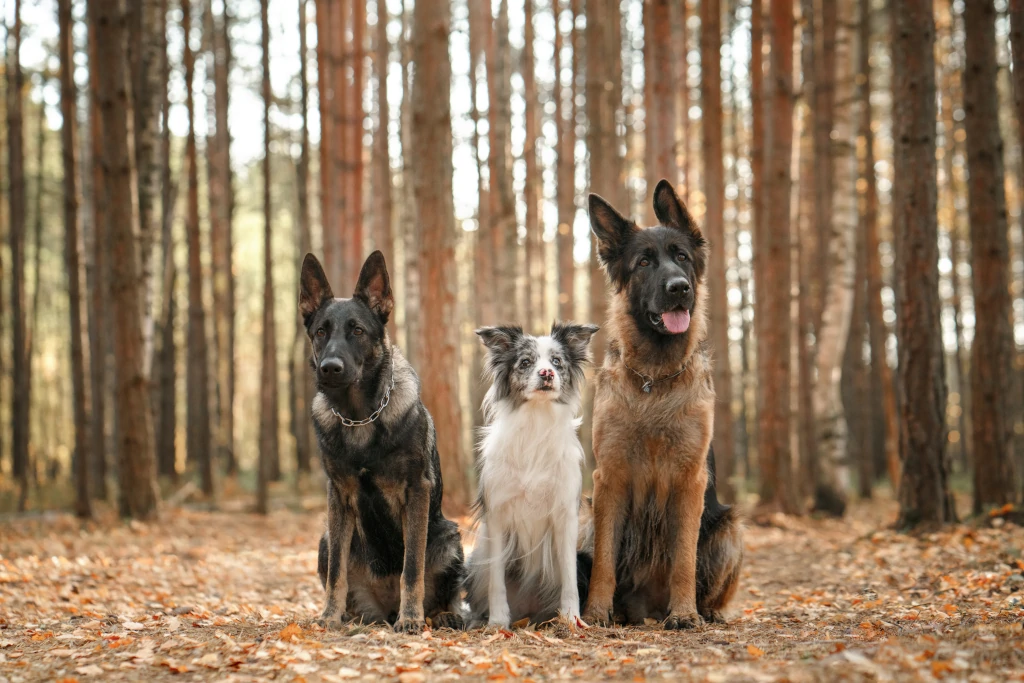
Shepherd dogs, often regarded as the heartbeat of pastoral communities, have journeyed with humanity through the ages.
These steadfast companions, from Anatolia’s vast plateaus to the Australian outback’s rugged terrains, have guarded our flocks, been our loyal allies, and served in roles far beyond their herding origins. Their diversity is a testament to their adaptability and our shared history.
From the majestic German Shepherd, often seen in roles of authority, to the delightful Corgi, which once herded cattle despite its diminutive size, each breed narrates a unique tale.
This article delves into these shepherd breeds’ histories, traits, and captivating stories, celebrating the richness they bring to our lives.
Whether you’re a potential dog owner, a history enthusiast, or simply someone looking to understand more about humans’ best friend, this guide promises insights that resonate and stories that inspire.
1. German Shepherd: The Universal Icon
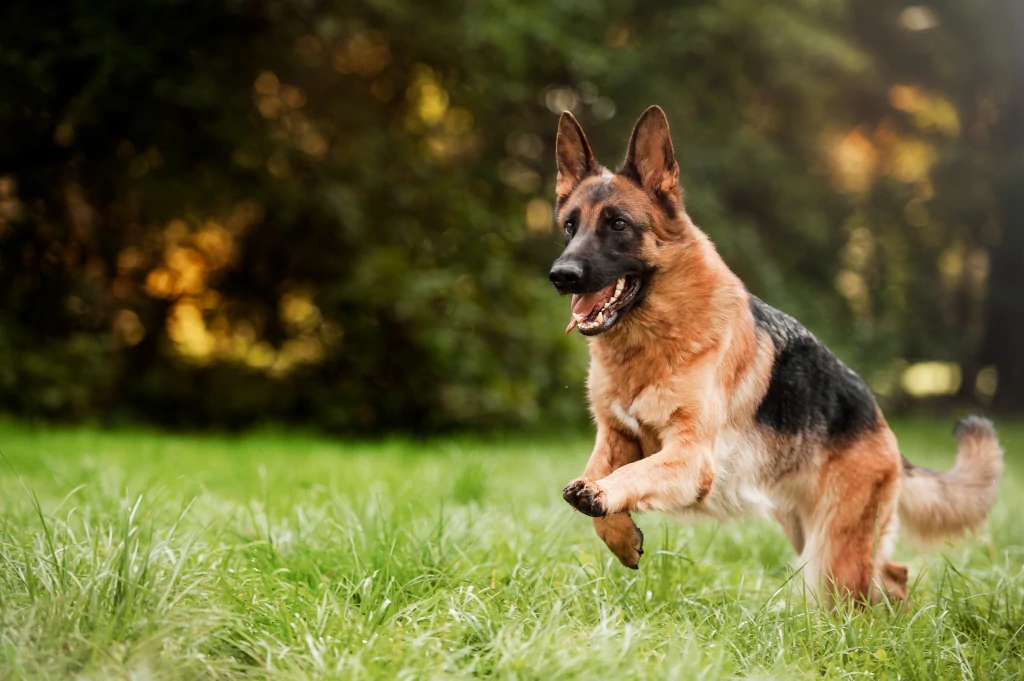
In the vast tapestry of canine breeds, the German Shepherd stands out as a veritable icon. Originating in Germany during the late 19th century, this breed was developed with a vision: to create the ideal working dog, one that combined intelligence, strength, and loyalty.
Captain Max von Stephanitz, often hailed as the father of the German Shepherd, envisioned a dog that could work alongside humans in any capacity. Today, his vision remains realized as German Shepherds consistently rank among the most versatile and reliable breeds.
The German Shepherd Dog’s appearance is a blend of elegance and power. Their well-proportioned bodies, alert ears, and intelligent eyes exude a sense of purpose and capability. With a double coat that varies from short to medium length, they’re equipped to handle various climates, from European winters to more temperate conditions.
But it’s not just their appearance that has earned the German Shepherd its widespread admiration. Their intelligence is second to none.
They’re quick learners with an innate sense of duty, making them ideal candidates for roles in police work, search and rescue operations, and even the entertainment industry. Rin Tin Tin and Strongheart, two early Hollywood canine stars, were testimony to the breed’s charisma and intelligence.
Their unwavering loyalty and protective instincts make German Shepherds excellent family pets as well. They form deep bonds with their families and are known to be especially gentle and patient with children. However, they’re not just couch potatoes; they thrive on activity, mental stimulation, and regular training.
In today’s world, the German Shepherd continues to wear many hats, from a dedicated police dog sniffing out evidence to a gentle therapy animal offering solace. Their adaptability and undying loyalty ensure their place in our hearts and homes. Truly, the German Shepherd’s reputation as a universal icon is both well-earned and well-deserved.
You May Also Like: German Shepherd Price Guide: Puppy Price, Initial Setup, & Ongoing Expenses
2. Australian Shepherd: The Misnamed Marvel
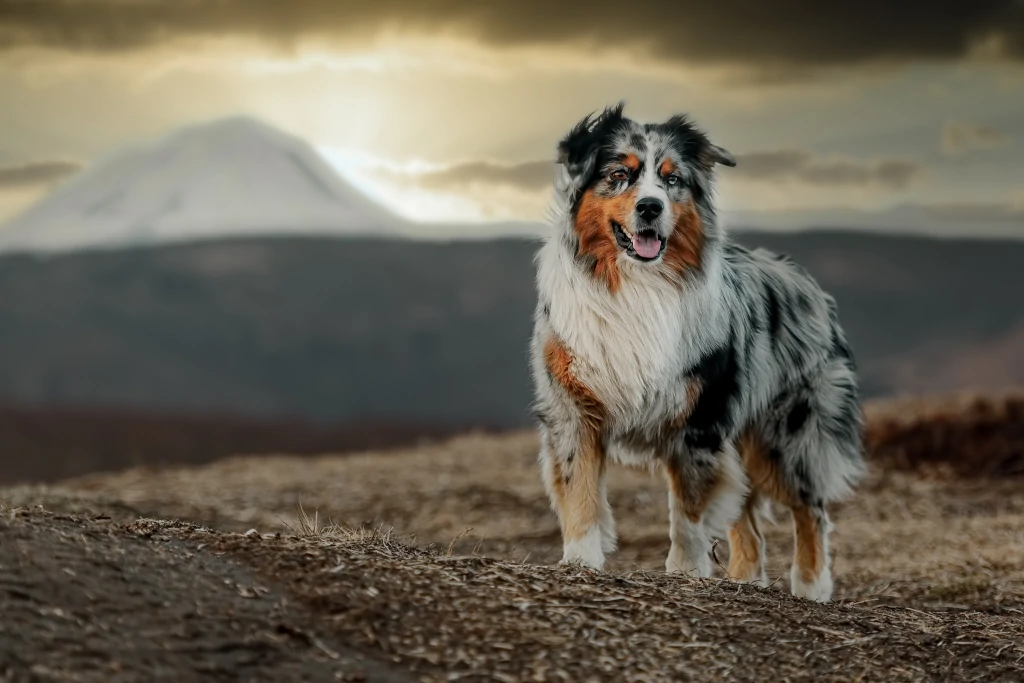
Despite its name, the origins of the Australian Shepherd are not rooted in the sunburnt landscapes of Australia but rather in the highlands and plains of the Pyrenees and America. A story steeped in mystery and wanderlust, the journey of this breed is as intriguing as its multi-colored eyes.
The Australian Shepherd, fondly known as the “Aussie,” traces its lineage back to the Basque region between Spain and France. Here, amidst the rugged terrains, local shepherds bred dogs that were agile, intelligent, and tireless workers.
When Basque shepherds set sail for the greener pastures of Australia in the 1800s, they took their faithful companions with them. In Australia, these European dogs were crossed with local breeds to further hone their herding capabilities.
By the time these shepherds and their canine companions reached the shores of the United States, the dogs had garnered the name ‘Australian Shepherd,’ perhaps due to their brief sojourn in Australia or as a nod to the Australian sheep they herded.
The Aussie’s striking appearance, marked by a merle coat and often heterochromia (two different colored eyes), is a visual delight. But beneath that dazzling exterior lies a brain that’s always ticking.
Renowned for their intelligence and energy, Australian Shepherds are quick learners, always eager to take on tasks or pick up tricks. Their boundless enthusiasm and agility make them stars in dog sports like agility, obedience, and herding events.
Beyond their working capabilities, Aussies are endearing family members. They are fiercely loyal, often attaching themselves to a particular member of the household. And while they make excellent companions, their high energy levels and sharp intellect demand regular physical activity and mental stimulation.
In contemporary society, the Australian Shepherd continues to win hearts, whether on a ranch, in a suburban backyard, or even in an apartment. Their ability to adapt, combined with their undying zest for life, ensures that the Australian Shepherd remains a cherished companion, a marvel with a misnomer for a name.
3. Belgian Shepherds: A Quartet of Distinction
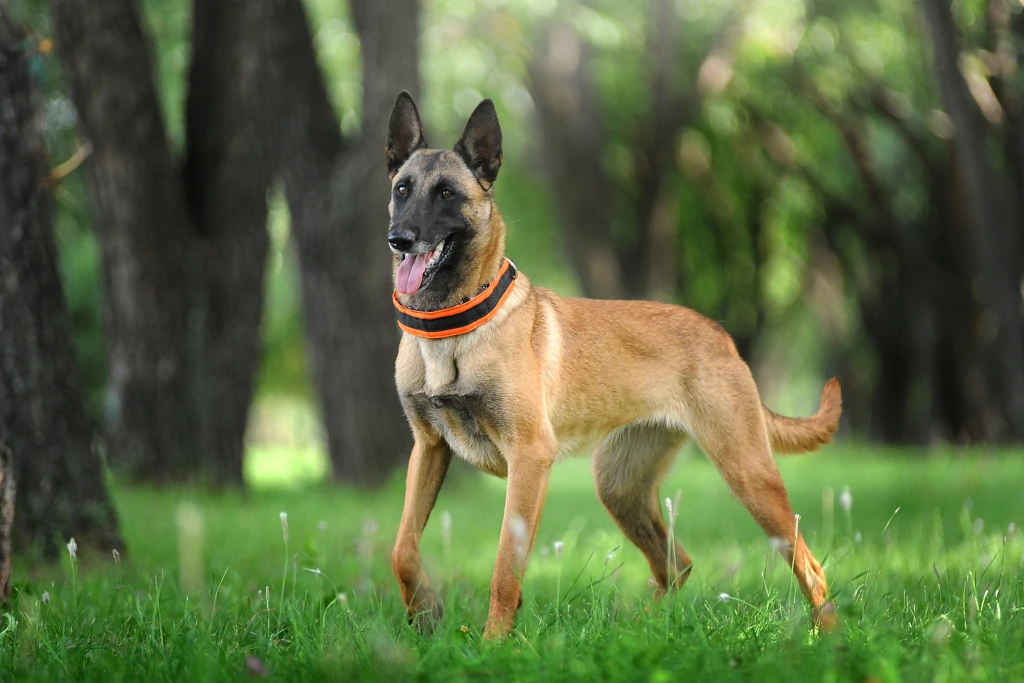
The rolling meadows of Belgium, a land renowned for its history, chocolates, and waffles, have yet another gift to the world: the Belgian Shepherds.
Unlike many breeds, when one speaks of the Belgian Shepherd Dog, they’re referring to not one but four distinct varieties, each showcasing a unique blend of elegance, agility, and devotion.
These four are the Tervuren, Malinois, Laekenois, and Groenendael, named after the regions in Belgium from which they hailed.
- Tervuren: Characterized by its rich fawn to russet mahogany coat with a black overlay, the Tervuren is a visual masterpiece. While its luxuriant coat might suggest a dog content with the finer things in life, the Tervuren is a workhorse, always eager to be in action. They are known for their sharp intelligence, ideal for obedience and agility tasks.
- Malinois: The Malinois, with its short, fawn-colored coat and black mask, is perhaps the most globally recognized of the quartet, thanks partly to its esteemed role in police and military operations. Valued for its relentless work ethic and keen instincts, the Malinois has proven indispensable in search and rescue missions, detection, and protection services.
- Laekenois: The rarest of the four, the Laekenois sports a rough, wiry coat, which historically served it well in its role as a guardian of linen fields. This variety is known for its strong protective instincts and a deep bond with its family, making it a reliable companion and watchdog.
- Groenendael: Dressed in a jet-black, long coat, the Groenendael, also known as the Belgian Sheepdog, is the epitome of canine grace. Their stunning appearance, combined with a keen intellect and an innate herding ability, has made them popular both as working dogs and family pets. They possess a charm that’s hard to resist, drawing admiration wherever they tread.
While each variety of the Belgian Shepherd showcases unique physical characteristics, they share common traits at their core. All are agile, intelligent, and intensely loyal, forming deep bonds with their human counterparts. Their work-centric origins mean they thrive best when given tasks or involved in activities challenging their minds and bodies.
Today, the Belgian Shepherds continue to serve in a multitude of roles – from herding and protection to companionship and showmanship. With its rich legacy and multifaceted talents, this quartet of distinction ensures that the Belgian Shepherd’s place in the annals of canine history remains prominent and revered.
You May Also Like: Belgian Malinois vs. German Shepherd: Differences & Similarities
4. Anatolian Shepherd: The Titan of Turkey
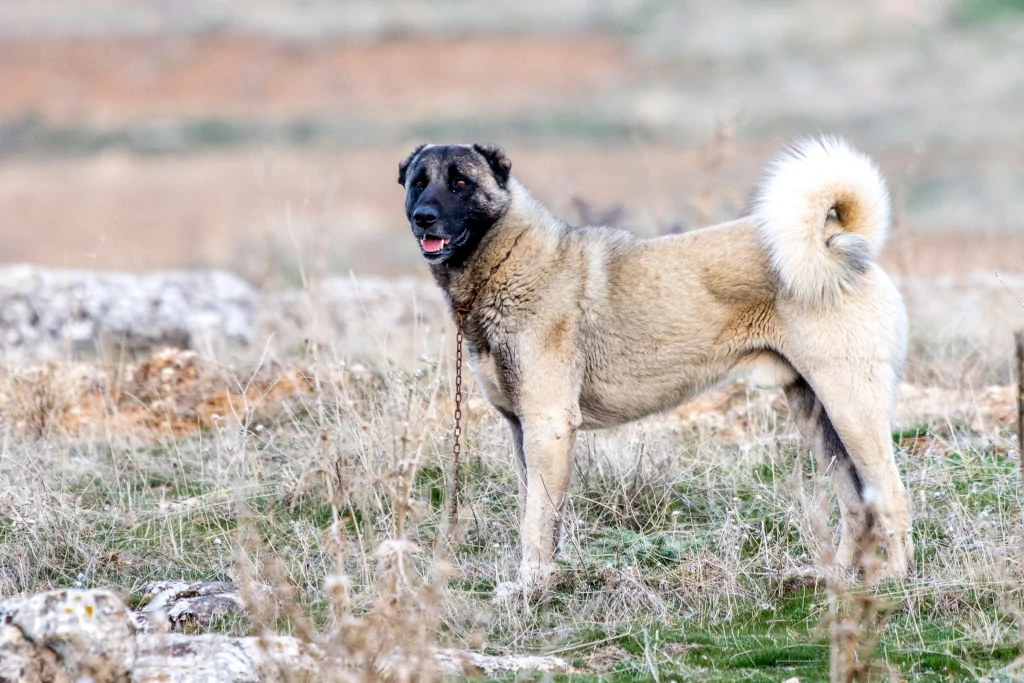
The Anatolian plateau of Turkey, with its vast landscapes and ancient history, has nurtured a guardian of epic proportions: the Anatolian Shepherd.
These majestic dogs, as old as the civilizations they’ve protected, have been the silent sentinels of Turkey’s livestock and homes for millennia. Towering in presence yet gentle in nature, the Anatolian Shepherd is a testament to endurance, loyalty, and unparalleled guarding instincts.
Originating from the Anatolia region, this breed’s primary role was to safeguard flocks from formidable predators like wolves, bears, and jackals. The vastness of the region meant that these dogs often worked independently, making decisions without human intervention.
Such a role demanded not only size and strength but also intelligence and discernment. The Anatolian Shepherd rose to the challenge, cultivating an uncanny ability to assess threats and respond with just the right level of assertiveness.
In appearance, the Anatolian Shepherd is a study in sturdiness and balance. Muscular and robust, they sport a short to rough double coat, providing them with the necessary insulation against the harsh climatic fluctuations of the Anatolian plateau. Their expressive eyes often likened to light amber or dark brown, radiate intelligence and quiet confidence.
Yet, beneath their imposing facade lies a heart of gold. To their families, Anatolian Shepherds are fiercely loyal and protective. While they can be reserved with strangers, they showcase unwavering devotion and affection to those they consider their own.
Their protective nature, however, means they require early socialization and consistent training to ensure they integrate well into diverse environments.
The contemporary world has seen the Anatolian Shepherd transition from the Turkish plateaus to homes across the globe. Whether they’re serving as loyal companions, farm guardians, or service dogs, their resilience and steadfast nature have won them admiration from all quarters.
5. Dutch Shepherd: The Brindle Beauty
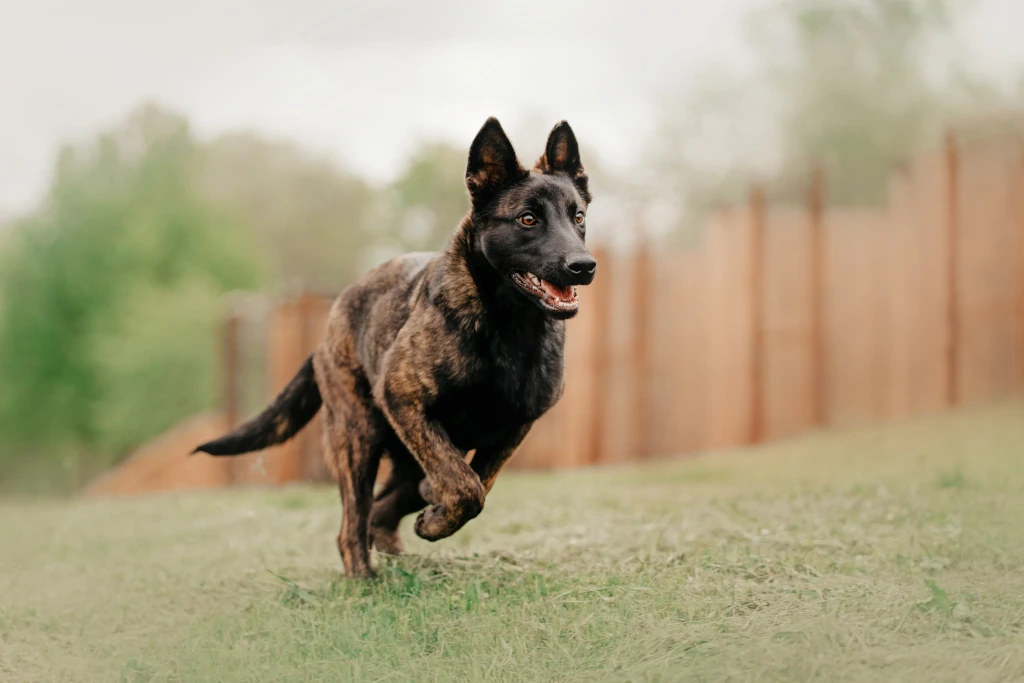
Nestled within the picturesque landscapes of the Netherlands, with its windmills, tulip fields, and serene waterways, emerges a breed that’s as captivating as the land from which it originates: the Dutch Shepherd.
Characterized by its distinctive brindle coat and unwavering work ethic, this breed is a harmonious blend of beauty, agility, and intelligence.
The origins of the Dutch Shepherd trace back to rural regions of the Netherlands. As a jack-of-all-trades, this breed took on a myriad of tasks, from herding sheep and cattle to guarding farmyards and even pulling carts.
Their versatility stemmed from an innate intelligence and a strong desire to work in tandem with their human counterparts. As agriculture evolved and machinery took over many farm tasks, the Dutch Shepherd adapted seamlessly into companion and protection roles, showcasing its remarkable adaptability.
One of the most eye-catching features of the Dutch Shepherd is its brindle coat, which comes in variations from gold to silver. The interplay of dark and light stripes gives it a regal and unique appearance, often drawing comparisons to wild and majestic landscapes.
While the short-haired variety is most commonly known, the Dutch Shepherd also sports long and rough-haired versions, each with its own distinct charm.
Beyond its appearance, the Dutch Shepherd’s temperament stands out. Alert and obedient, they form deep bonds with their families, showcasing loyalty that’s second to none. They are particularly known for being good with children, making them ideal family dogs.
Their intelligence means they excel in obedience and agility trials, and their even-tempered nature makes them a favorite in therapy and service roles.
However, like all working breeds, the Dutch Shepherd thrives on activity and mental stimulation. They are happiest when given tasks or when they can engage in play, training, or exercise. A well-socialized and trained Dutch Shepherd is a joy to have, offering both companionship and a sense of security.
Today, as the world discovers the multifaceted talents of the Dutch Shepherd, its popularity is on the rise. From its origins in the pastoral scenes of the Netherlands to homes and competitions worldwide, the Dutch Shepherd, with its brindle beauty and impeccable character, continues to enchant and inspire.
You May Also Like: Dutch Shepherd vs. Belgian Malinois: Differences & Similarities
6. Border Collie: The Focus Master
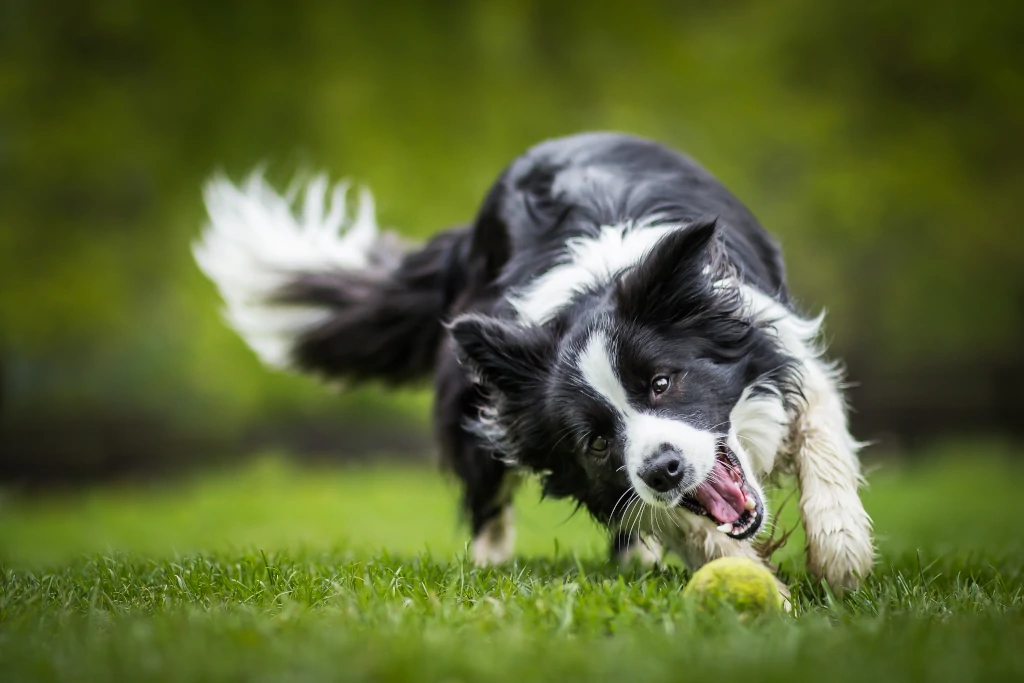
Emerging from the rugged terrains and undulating hills of the Anglo-Scottish border, the Border Collie is not just a dog; it’s a phenomenon.
Renowned globally for its laser-sharp focus, unmatched agility, and intelligence that often seems uncannily human, the Border Collie has earned its title as one of the most astute and capable breeds in the canine kingdom.
The heritage of the Border Collie is deeply intertwined with the shepherding culture of the British Isles. Designed for endurance and precision, this breed became an irreplaceable partner to shepherds, deftly managing vast flocks with minimal guidance.
What sets the Border Collie apart is its distinctive “herding eye” — an intense gaze that it uses to control and maneuver sheep.
Visually, the Border Collie is a harmonious blend of grace and function. Their athletic build, paired with a coat that ranges from smooth to rough, equips them for the often harsh climates of their homeland. Their expressive eyes, whether deep brown, blue, or even one of each, mirror a mind that’s always alert and calculating.
However, the brilliance of the Border Collie is not merely physical. Their cognitive abilities are legendary.
They possess an unparalleled capacity to learn commands, with some seasoned dogs recognizing hundreds of distinct cues. This intellectual prowess, combined with their boundless energy, has made them champions in dog sports, particularly in agility and obedience competitions.
While their capabilities are vast, Border Collies are not for everyone. Their intense drive and intelligence require regular mental and physical stimulation.
Without proper engagement, they can become bored, leading to unwanted behaviors. Yet, in the right environment, they flourish. They’re loyal companions, often forming a deep and unique bond with their owners.
Today, the Border Collie’s reputation extends far beyond the pastures. From search and rescue operations to starring roles in cinema and even as therapeutic companions, their versatility is evident.
The Border Collie, with its unmatched focus and exceptional intellect, stands as a testament to the incredible synergy between humans and dogs, proving time and again that when it comes to partnership, they are in a league of their own.
7. Rough Collie: The Elegant Stalwart
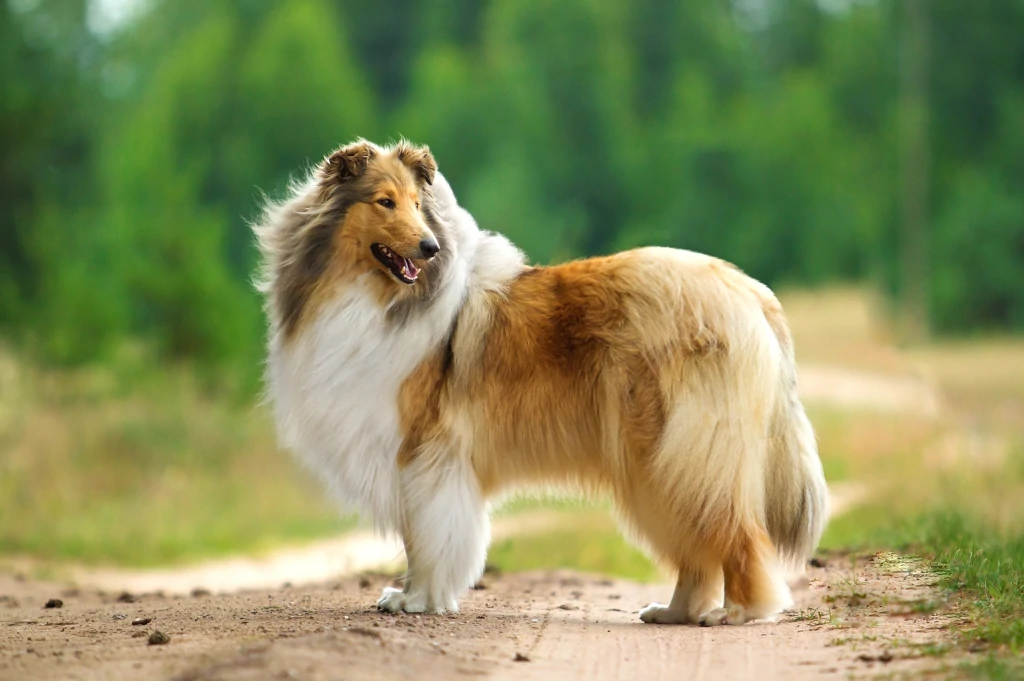
Whisked from the sweeping Scottish Highlands, the Rough Collie is a vision of elegance and poise. With its refined features, luxuriant mane, and an aura that radiates nobility, it’s no wonder this breed has captured hearts worldwide. Beyond its beauty, the Rough Collie is a steadfast companion, embodying a mix of sensitivity and strength.
Historically, the Rough Collie’s ancestors were reliable herding dogs, guiding livestock across the challenging terrains of Scotland. Their keen senses, especially their sharp hearing, made them particularly adept at this role.
However, as the breed evolved and was refined, it transitioned from a worker on the fields to a beloved companion in homes and a show-ring favorite.
The Rough Collie’s appearance is undeniably striking. Its well-defined muzzle, almond-shaped eyes that sparkle with intelligence, and a mane that rivals any royal’s cloak give it a regal demeanor. The coat, which can come in colors ranging from sable and white to tri-color, requires regular grooming to maintain its splendor.
But the allure of the Rough Collie isn’t merely skin deep. Their temperament is just as endearing.
Known for their gentle and affectionate nature, they bond deeply with families and are especially fond of children. Their intuitive nature often means they can sense the mood of their household, offering comfort during times of distress or joining in gleefully during moments of joy.
Though they carry an air of sophistication, Rough Collies are not aloof. They’re alert and vigilant, making them reliable watchdogs. However, they are not aggressive; instead, they use their barks judiciously to alert their owners of any anomalies.
The Rough Collie’s legacy is also etched in popular culture. Thanks to literary and cinematic works like “Lassie,” the breed has become synonymous with loyalty, bravery, and an unwavering commitment to their human counterparts.
For prospective dog owners looking for a blend of elegance, intelligence, and loyalty, the Rough Collie emerges as a top contender. As a family companion, a guardian, or a show-ring star, the Rough Collie, with its majestic presence and devoted heart, continues to be an emblem of canine grace and fidelity.
8. Shetland Sheepdog: The Miniature Maestro
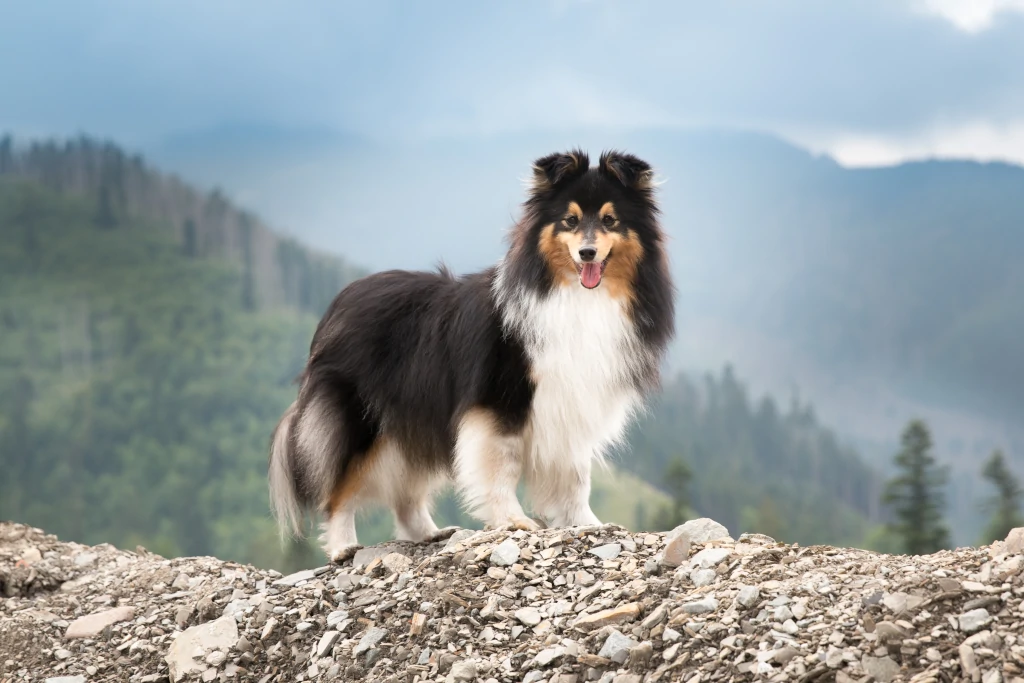
From the windswept, remote islands of Shetland, a diminutive dynamo has emerged, winning admirers far beyond its native shores.
The Shetland Sheepdog, affectionately known as the Sheltie, may bear a resemblance to its larger cousin, the Rough Collie. But with its keen intelligence, agility, and a heart full of devotion, the Sheltie stands proudly in its own right.
The rugged environment of the Shetland Islands called for a hardy, versatile dog. Originally bred to herd and guard livestock in this challenging terrain, the Shetland Sheepdog’s compact size was a natural adaptation, allowing it to move swiftly while consuming less food.
But make no mistake; what the Sheltie lacks in size, it more than compensates for in spirit and capability.
Visually, the Shetland Sheepdog is a picture of symmetry and grace. Its fine features, tipped ears, and mane-like rough give it an air of elegance, while its penetrating gaze reflects a mind constantly at work. Their sable, tri-color, or blue merle coats are dense, providing protection against the harsh Shetland weather.
But Sheltie’s true genius lies in its temperament and abilities. Their intelligence is legendary. Often ranking among the top obedience breeds, they excel in agility, herding, and other dog sports.
Their keen senses and alert nature make them excellent watchdogs, always vigilant to changes in their surroundings. But it’s their unwavering loyalty and affectionate nature that endears them most to their human families. They form strong bonds, often shadowing their favorite people around the home.
As with many intelligent breeds, Shelties thrive on mental stimulation and training. Their eagerness to please, paired with their sharp minds, means they pick up commands quickly, though they do appreciate consistency in training methods.
Today, while they may no longer be primarily herding sheep on the Shetland Islands, Shelties have found their place in countless homes worldwide.
As companions, show dogs, or agility champions, their versatility knows no bounds. The Shetland Sheepdog, with its combination of beauty, brains, and boundless energy, stands as a testament to the wonders that can emerge from even the most isolated and challenging environments.
9. Corgi: Royalty in Compact Form
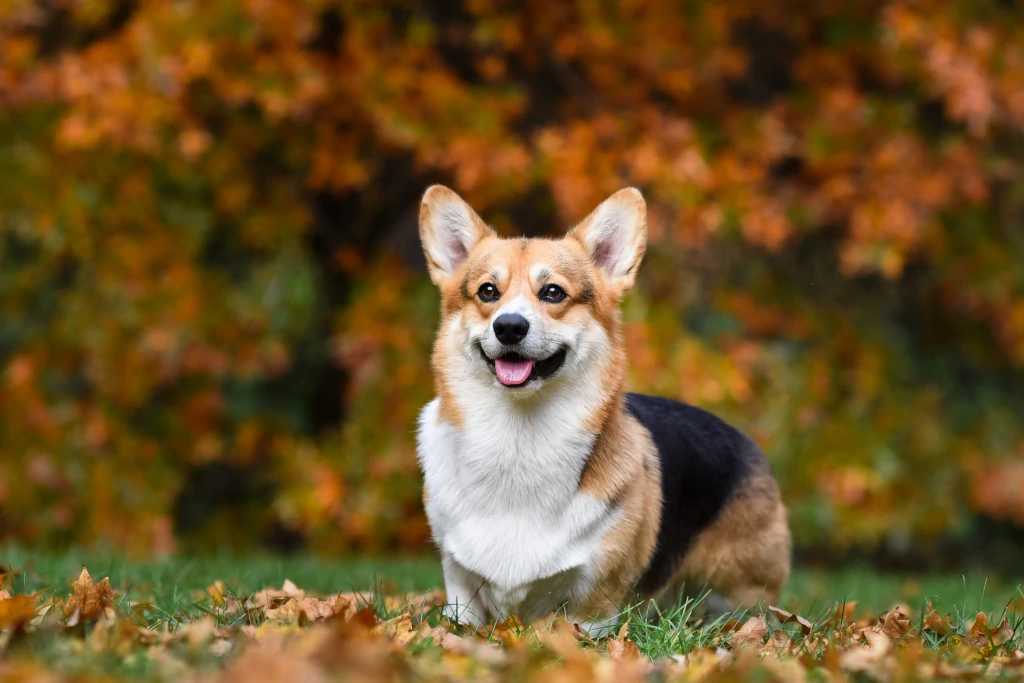
From the lush valleys of Wales comes a breed that effortlessly marries charm, wit, and stature, all within its compact frame. The Corgi, with its playful demeanor, stout heart, and unmistakable silhouette, isn’t merely a dog; it’s British canine royalty.
Whether you’re smitten by the Pembroke or the Cardigan variety, one thing remains undeniable: the Corgi is a regal powerhouse.
The annals of Welsh folklore hint at the fairy-touched origins of these spirited dogs. Legends speak of them being the preferred mounts for woodland fairies, their characteristic markings said to be left by fairy saddles and harnesses.
While the whimsy of folklore adds to their allure, Corgis have been earth-bound companions to humans for centuries, primarily serving as herders of cattle and sheep.
Undoubtedly, a defining feature of the Corgi is its appearance. Short but in no way small, they possess sturdy bodies set atop stout legs, crowned with an expressive face often lit up by a mischievous sparkle in their eyes. Their ears, standing erect and ever-alert, further accentuate their animated expressions.
But perhaps the most royal connection that has solidified the Corgi’s esteemed status is their association with the British monarchy.
Most notably, Queen Elizabeth II’s fondness for the breed has been well-publicized throughout her reign. Her lifelong affinity for Corgis has only intensified the breed’s popularity and global recognition.
In temperament, Corgis are a delightful paradox. They’re robust and rugged yet affectionate and amiable. Their intelligence is evident, and they often display a witty, even clownish side, entertaining families with their antics. But they’re also fiercely loyal, forming deep bonds with their families, and can be surprisingly protective, given their size.
Today, while they may no longer be as actively involved in herding, their presence is felt in countless homes, agility courses, and even in the annals of internet fame.
Their short stature, combined with a long history and an even longer list of admirers, ensures the Corgi’s place in the spotlight. Whether in palaces, pastures, or living rooms, the Corgi remains an enduring symbol of spirited royalty, bringing joy in its every step and bark.
10. Australian Cattle Dog: The Outback Dynamo
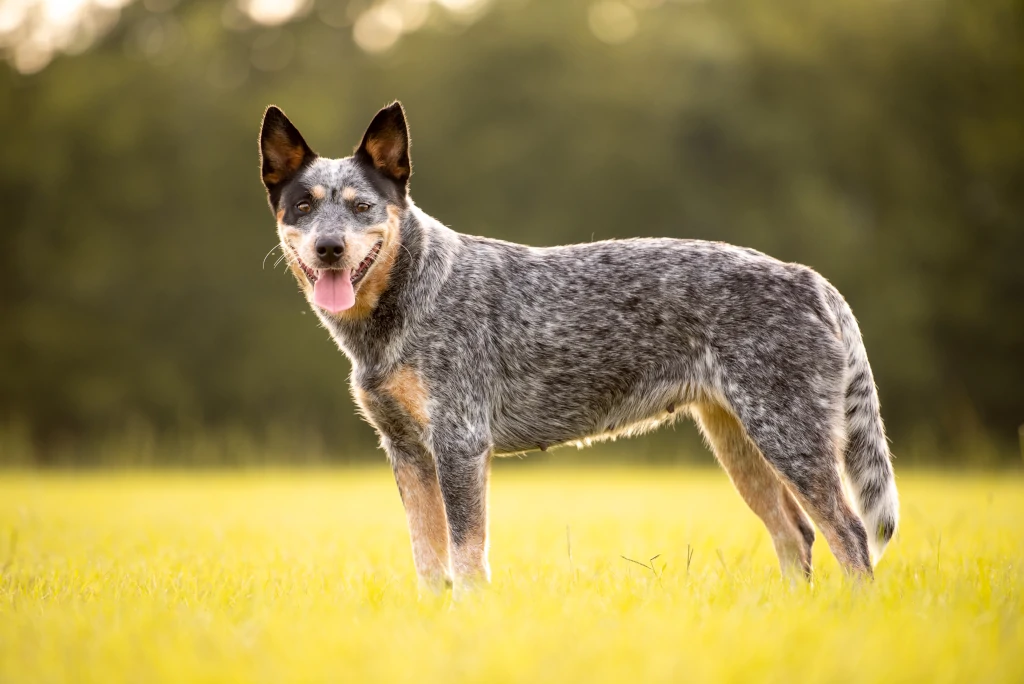
Born amidst Australia’s sprawling vistas and rugged landscapes, the Australian Cattle Dog is a symphony of stamina, intelligence, and tenacity.
Rooted in the demands of the vast Australian outback, this breed, with its distinctive coat mottled or speckled in blue or red, has evolved as a herding dog, tirelessly driving cattle across expansive terrains.
The history of the Australian Cattle Dog is a tale of innovation and adaptation. Early settlers in Australia needed a robust dog that could handle the harsh climate, rough terrain, and long distances, all while managing stubborn cattle.
Through selective breeding involving breeds like the wild Dingo, Scottish Highland Collie, and Dalmatian, the result was a breed uniquely equipped for the challenges of the Australian landscape.
Visually, the Australian Cattle Dog is a compact, muscular marvel. Its dense double coat, designed to offer protection from extreme weather conditions, is beautifully adorned with a pattern of speckles and mottles. This, paired with their piercing eyes, offers a gaze that’s as intense as it is mesmerizing.
But it’s in their performance and character where the Australian Cattle Dog truly shines.
Known for their boundless energy, they’re workaholics by nature. They drive cattle not just by barking but also by nipping at their heels, showcasing their fearless disposition. Their sharp intelligence, combined with an independent streak, means they’re quick learners but also require consistent training and early socialization.
Beyond the fields, the Australian Cattle Dog makes for a fiercely loyal companion. Their devotion to their owners is unwavering, and while they can be wary of strangers, they’re known to be affectionate with their families.
However, their high energy levels and mental acuity mean they thrive best in active homes where they’re given tasks to do or problems to solve.
Today, beyond the vast plains of Australia, the breed has found its place in various canine sports, search and rescue missions, and, of course, as beloved family members. The Australian Cattle Dog, with its determination, agility, and heart, stands as a testament to the spirit of the outback, ever-ready to rise to any challenge.
11. Miniature American Shepherd: A Smaller Legacy
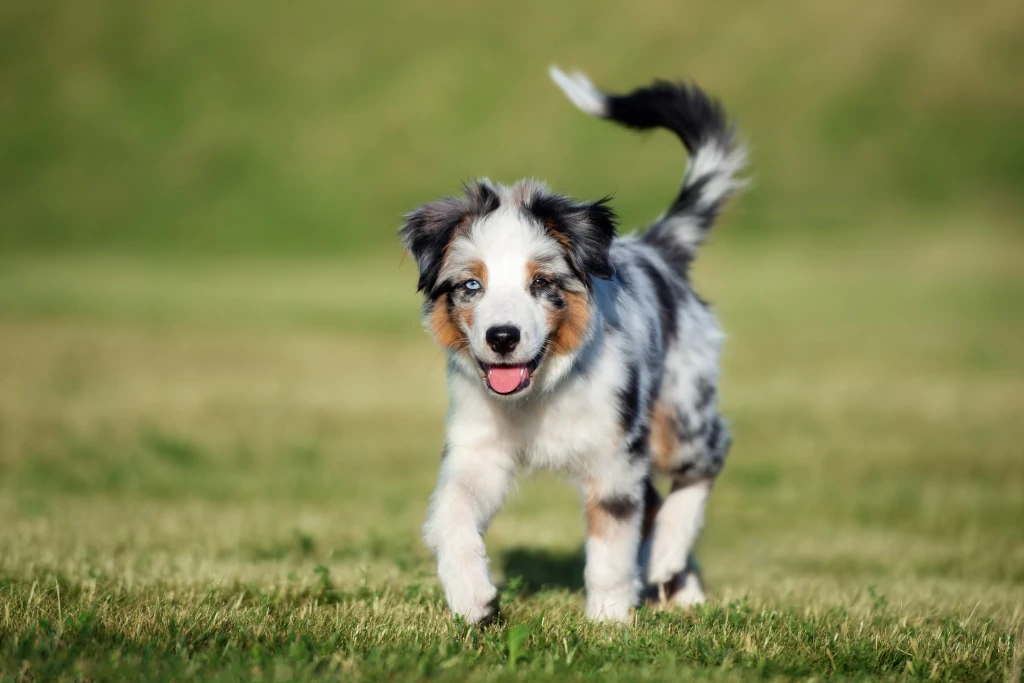
In the tapestry of canine breeds, there are those that pack the spirit, intelligence, and grace of their larger counterparts into a more compact form, and the Miniature American Shepherd is a stellar exemplar of this.
Evoking the heritage of the renowned Australian Shepherd, yet distinct in its own right, this smaller variant emerges not as a mere diminution but as a breed teeming with vibrancy and character. Behold the Miniature American Shepherd: A legacy rendered in a more petite yet equally potent frame.
Originating in the United States in the 1960s, the Miniature American Shepherd was bred to cater to the growing demand for a dog with the aesthetics and talents of the Australian Shepherd, yet suited for more urban or constrained environments. With their smaller size came no compromise on their agility, herding abilities, or zest for life.
Aesthetically, the Miniature American Shepherd is a captivating sight. Their multi-colored coats, often adorned with intricate merle patterns, ripple with every movement, reflecting shades ranging from blue merle, red merle, black, and red. Their almond-shaped eyes, often heterochromatic in some individuals, exude intelligence and curiosity.
But beyond their beauty lies a brain and a heart that’s truly remarkable.
Miniature American Shepherds are renowned for their agility and are frequent participants, often stars, in various dog sports. Their herding lineage shines through, be it in an agility course or a bustling household. Their intelligence is paired with an eagerness to please, making training a rewarding experience for both the dog and the owner.
Being smaller doesn’t mean they’re any less active. In fact, these dynamos thrive on activity and mental stimulation.
They form deep bonds with their families and often appoint themselves as the household’s vigilant watchdogs. While their barks are reserved, they’re quick to alert their families of any anomalies.
Today’s Miniature American Shepherd stands as a bridge between the past and the present.
They evoke the legacy of the revered herding dogs from which they descended, yet are perfectly suited for today’s modern lifestyles, whether in an apartment in the city or on a sprawling farm. The Miniature American Shepherd, in its compact form, continues to be a testament to the adage that great things often come in small packages.
12. Old English Sheepdog: The Shaggy Sentinel
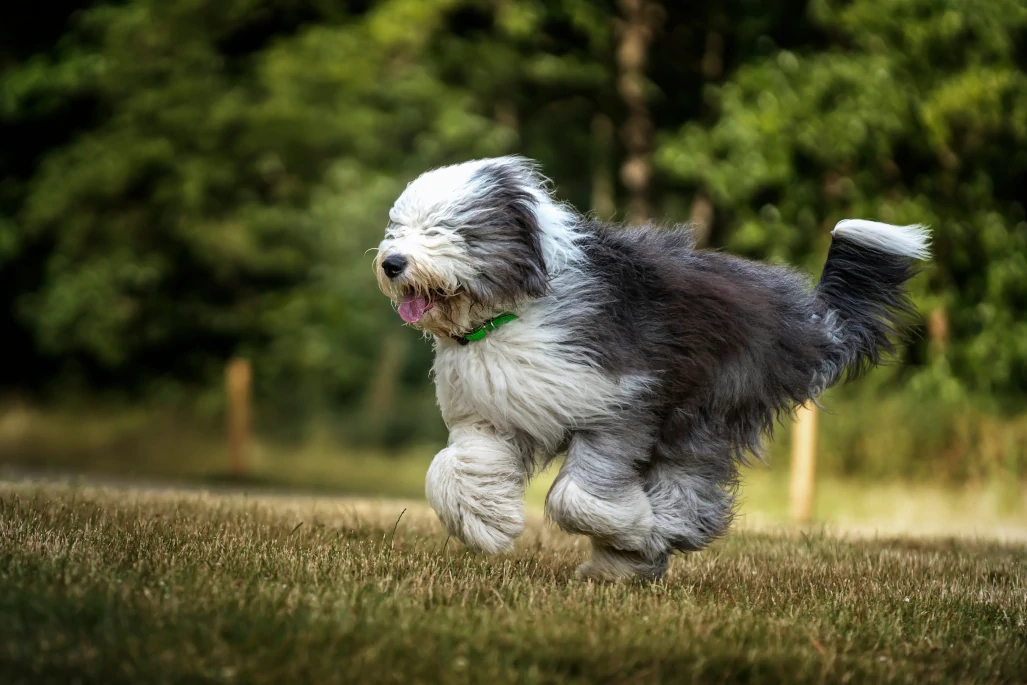
Amid England’s verdant pastures and rolling hills, a distinctive silhouette has stood the test of time, both as a diligent worker and a cherished companion. With its cascading waves of shaggy fur and a gait that’s almost bear-like, the Old English Sheepdog is more than just a memorable figure. It is the embodiment of pastoral charm and steadfast loyalty.
The origins of the Old English Sheepdog, though shrouded in mystery, are deeply intertwined with the agricultural heritage of England. Bred primarily to drive cattle and sheep to market, this breed was not just a herder but a protector, ensuring livestock reached their destination without the interference of predators or thieves.
From nose to tail (or rather, the lack of it), the Old English Sheepdog is an ode to uniqueness. Its iconic coat, dense and profuse, provides both protection against the elements and a signature look that’s hard to miss. Beneath the layers of hair, a pair of expressive eyes twinkle with intelligence and mischief, only adding to their enchanting persona.
But the charm of the Old English Sheepdog isn’t just skin deep. At its heart, this breed possesses a friendly and dependable temperament.
Their protective instincts make them vigilant guardians of their homes, yet they greet family and friends with an unmistakable warmth and vitality. Known for their clownish antics and playful nature, they often retain a puppy-like demeanor well into their adult years.
Training the Old English Sheepdog, thanks to its sharp intelligence, can be a smooth experience.
But potential owners should be prepared for a touch of stubbornness, a trait often masked by their goofy grin. They respond best to positive reinforcement and thrive in an environment where they’re given ample attention and mental stimulation.
Today, while their role in herding may have diminished, the Old English Sheepdog has found a new calling as a beloved family member, show-ring champion, and even a pop culture icon. From movies to advertisements, their unmistakable appearance and endearing personality have captured hearts worldwide.
The Old English Sheepdog, with its combination of beauty, brawn, and kindness, remains a cherished emblem of English heritage, standing tall as the shaggy sentinel it has always been.
13. White Swiss Shepherd Dog: Alpine Elegance
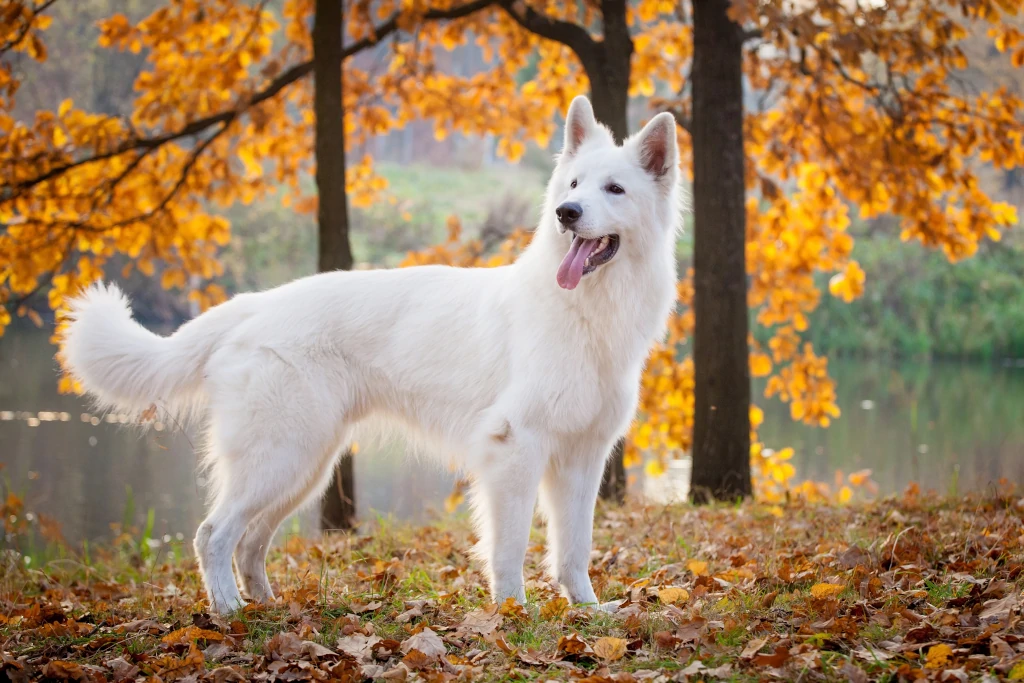
Nestled within the serene vistas of the Swiss Alps, a breed emerges that seamlessly blends grace, function, and elegance, capturing the very essence of its majestic surroundings.
The White Swiss Shepherd, with its pristine coat and poised demeanor, is more than just another herding dog. It embodies Alpine’s sophistication and robustness, symbolizing the purity and resilience of the mountains from which it draws its name.
The White Swiss Shepherd, though bearing striking similarities to its cousin, the German Shepherd, carves its own unique identity.
Born from the white-coated lines of the German Shepherd, this breed eventually diverged, both in appearance and temperament and found its roots in Switzerland. Recognized as a separate breed, the White Swiss Shepherd is a testament to the breeders’ vision of a shepherd dog that combines strength and elegance.
Visually, the White Swiss Shepherd is an arresting sight. Its luxurious, snow-white coat flows effortlessly as it moves, reflecting its inherent grace and agility. The coat, dense and weather-resistant, speaks of the breed’s adaptability to the Alpine climate, while its keen, almond-shaped eyes betray a depth of intelligence and sensitivity.
Beneath its glorious exterior, the White Swiss Shepherd boasts a temperament that’s both balanced and affable.
Renowned for its loyalty and keen sense of duty, it thrives when given a purpose, whether as a herding dog, a guardian, or a devoted family companion. Their approachability and gentle nature make them particularly endearing to children, and their alertness ensures they are vigilant protectors of their homes.
While their beauty and elegance are unmistakable, these shepherds are not mere showpieces. They’re hardworking, adaptable, and quick learners, excelling in various canine activities, from obedience and agility to search and rescue missions.
In today’s world, the White Swiss Shepherd has expanded its horizons beyond the Alpine meadows. It’s found in homes worldwide, revered not just for its beauty but for its unwavering loyalty and impeccable character.
14. Bergamasco Sheepdog: The Dreadlocked Guardian
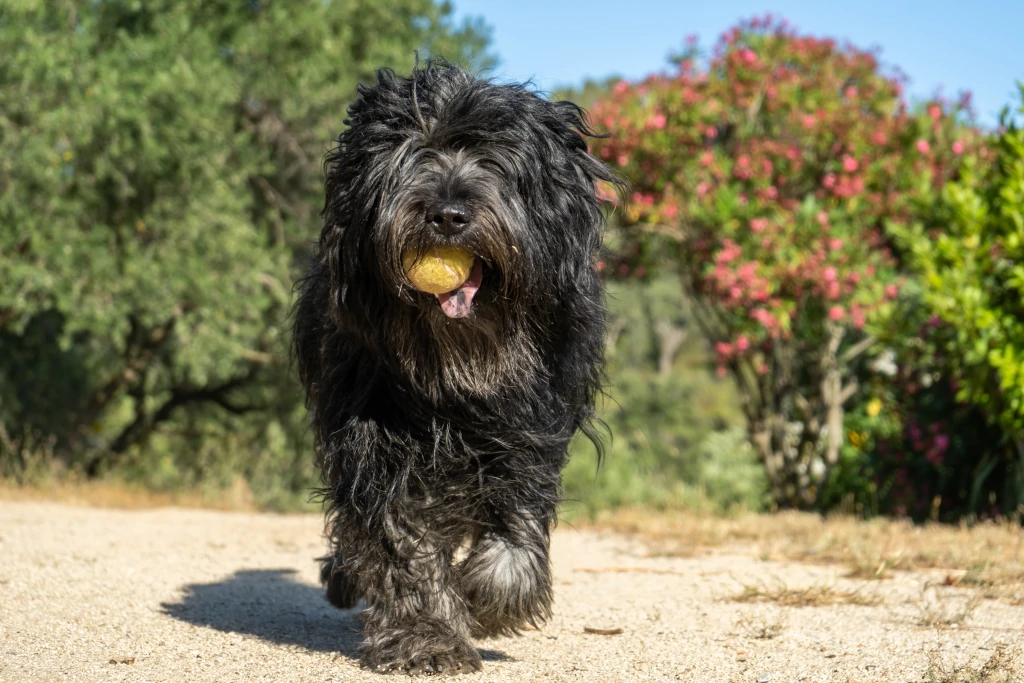
Amidst the picturesque valleys of the Italian Alps, where rugged landscapes meet age-old traditions, a unique canine protector emerges.
The Bergamasco Sheepdog, with its distinctive, matted coat resembling dreadlocks, stands out not just for its appearance but for its unwavering commitment to its flock. Beneath the intricate layers of its wooly flocks lies the heart of a guardian—loyal, intelligent, and profoundly instinctual.
The origins of the Bergamasco Sheepdog date back over a thousand years, with the breed honing its skills amidst the challenging terrains of the Bergamo region in Northern Italy.
Bred to be vigilant shepherds, their main duty was to herd and safeguard sheep from predators, and their dreadlocked coats played a crucial role. This unique coat provided protection against harsh weather conditions and potential harm from predators, making it both functional and emblematic.
Beyond its fascinating exterior, the Bergamasco’s coat is a marvel of nature. Comprising three types of hair that naturally mat together, the flocks form over time, evolving from a fluffy puppy coat to the felt-like strands seen in adults. This doesn’t just give them a captivating appearance; it’s also a low-maintenance coat that rarely sheds and requires minimal grooming.
At its core, the Bergamasco Sheepdog is a thinking breed. Their herding style is built on observation and understanding rather than mere instinct. This analytical approach, combined with their natural patience, makes them exceptionally good problem solvers.
As companions, they are gentle, loving, and deeply attached to their families. Their protective instincts are always on alert, yet they demonstrate a calm and measured response, making hasty reactions rare.
Training a Bergamasco requires understanding their analytical nature. They’re keen learners, but repetition without reason can bore them. A mix of positive reinforcement and task variation works best, tapping into their innate desire to work and think.
In the modern world, the Bergamasco Sheepdog has extended its guardianship beyond the Italian meadows.
While they still embody their shepherd roots, they’ve seamlessly transitioned to being loyal family guardians and therapy dogs, their calm and empathetic nature making them particularly suited for the latter.
15. Briard: The French Pastoral Gem
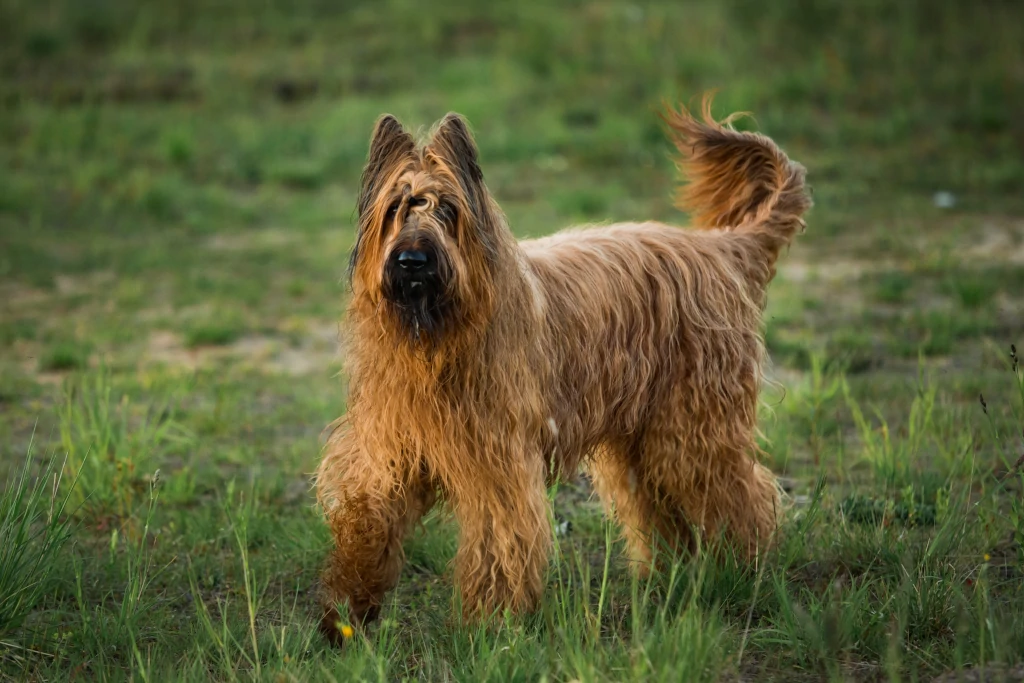
In the sprawling meadows and vine-laden valleys of France, where history intertwines with pastoral poetry, emerges a canine companion as captivating as the tales told beside ancient fireplaces.
The Briard, with its flowing, lustrous coat and spirited disposition, is a treasure of French heritage, standing as a testament to the nation’s profound connection with its pastoral roots.
The Briard’s lineage can be traced back to the 8th century, with legends suggesting that Charlemagne himself had specimens of this diligent herder.
Revered for its adeptness in protecting flocks from predators and its unrivaled loyalty to its shepherd, the Briard quickly established itself as an invaluable asset in rural French communities. Over time, this working dog’s reputation expanded beyond its herding prowess to include its role as a sentinel during wars and a loyal companion to French nobility.
Aesthetically, the Briard is a masterpiece of canine design. Its long, wavy coat, which can range from shades of fawn to black, gives it a regal appearance.
Adding to its allure are its expressive eyes, often hidden beneath a fringe of fur, that shimmer with intelligence and curiosity. The “double dewclaws” on its hind legs further accentuate its uniqueness, a trait cherished by breed enthusiasts.
Yet, the true allure of the Briard lies in its character. This breed epitomizes loyalty. Stories abound of Briards traveling vast distances to reunite with their families or standing guard over their flock with an unwavering sense of duty. Their intelligence is complemented by their eagerness to please, making them not just excellent working dogs but also loving family members.
That said, their independent nature, a trait honed from making decisions in the field, means that early training and socialization are crucial for a harmonious relationship.
Today, while the pastoral landscapes of France have evolved, the Briard’s essence remains untouched. In urban settings, its versatility shines through, adapting to roles ranging from search and rescue to therapy and even excelling in dog sports.
16. Beauceron: Gallic Strength and Versatility
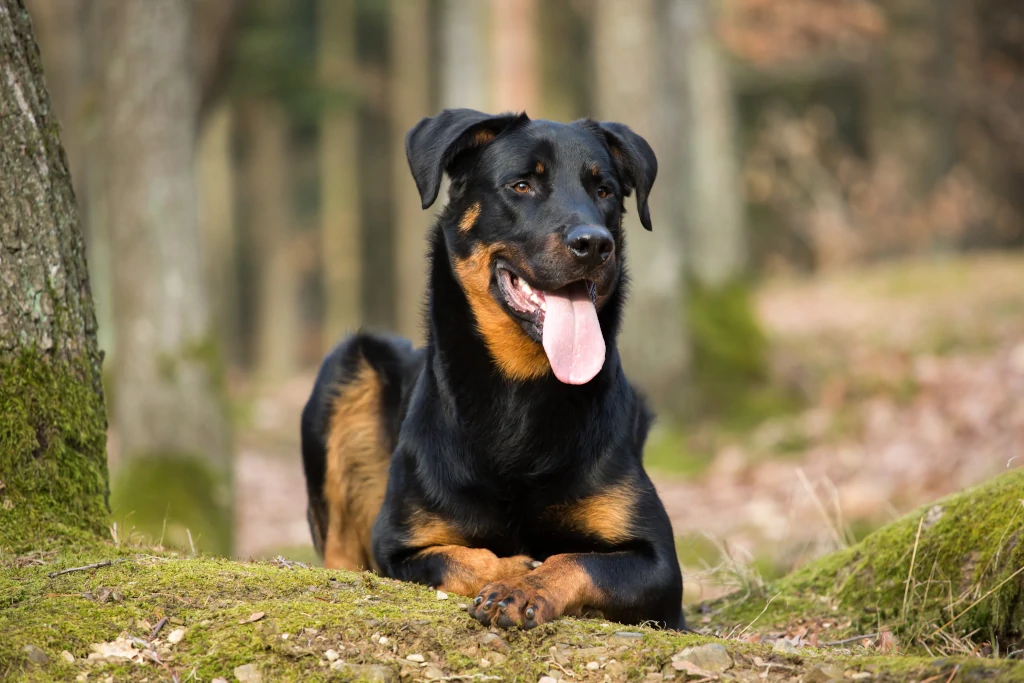
Across the fertile plains of Northern France, where the land is as robust as the tales of its historic battles, strides a breed epitomizing both strength and versatility.
The Beauceron, a compelling blend of elegance and power, stands proud as a beacon of France’s working dog heritage, capturing the essence of Gallic tenacity and adaptability.
Delving into the annals of French history, the Beauceron’s roots can be traced back to the Renaissance era. Originally bred in the La Beauce region, from which it gets its name, this breed was the shepherd’s right hand, adept at herding large flocks and guarding them against predators.
As the demands of pastoral life evolved, so did the Beauceron, showcasing its versatility not just as a herder but also as a protector of homesteads and, in wartime, as a messenger and mine detector.
Physically, the Beauceron is an embodiment of athletic prowess. Its muscular frame, accentuated by a sleek, short double coat, exudes strength without compromising on agility.
Its dark brown, watchful eyes, coupled with a confident stance, speak volumes of its alertness and intelligence. The breed’s distinct double dewclaws on the hind legs stand as a unique hallmark, cherished and preserved by breed enthusiasts.
But to truly understand the Beauceron is to delve into its character. This is a breed known for its loyalty and courage. Its protective instincts make it an unparalleled guardian, yet it approaches its duties with a measured calmness rather than aggression.
Intelligent and eager to please, the Beauceron thrives on challenges, be it in obedience, agility, or herding trials. However, their strong-willed nature necessitates early training and consistent leadership.
Modern times have seen the Beauceron’s roles diversify even further. Beyond pastoral duties, they’ve proven themselves in search and rescue operations, police work, and as unwavering family protectors and companions. Their adaptability, coupled with an innate desire to work, has cemented their reputation not just in France but globally.
17. Caucasian Shepherd Dog: The Mountainous Guardian
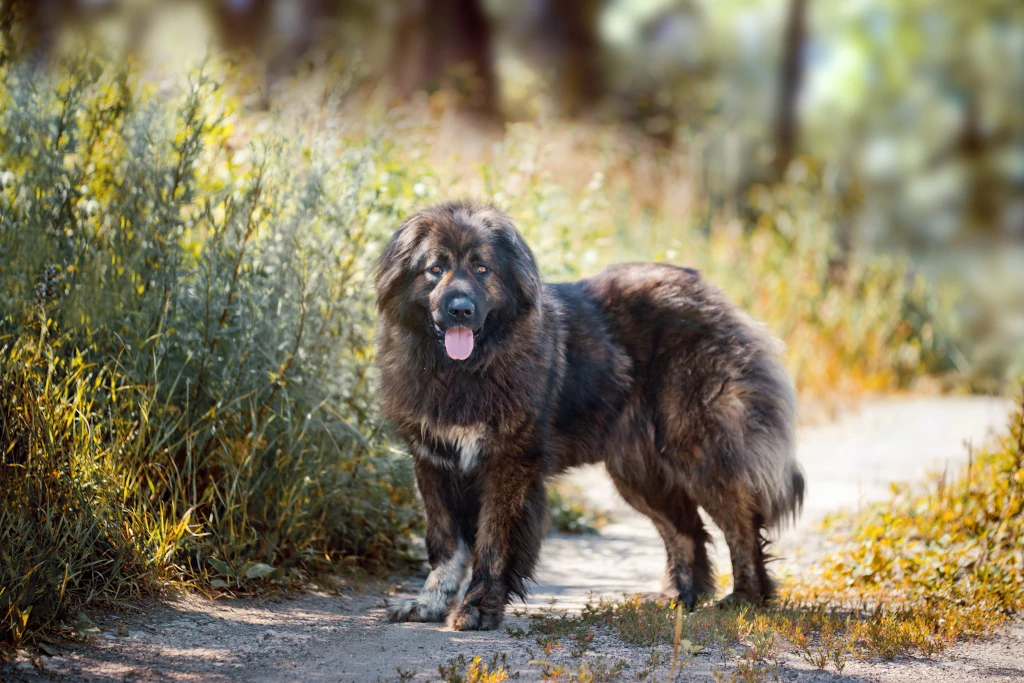
The Caucasian Shepherd, with its imposing stature and formidable presence, reigns supreme as the guardian of these ancient peaks, symbolizing the untamed spirit of the mountainous expanse.
Tracing the lineage of the Caucasian Shepherd is akin to traversing the pages of an old legend. For millennia, this breed has been the stalwart defender of the native peoples and their livestock against formidable predators, including wolves, coyotes, and bears.
Born from the necessity of survival, the Caucasian Shepherd has honed its protective instincts to perfection, making it one of the most revered guard dogs in history.
Visually, the Caucasian Shepherd is nothing short of awe-inspiring. Its robust build, characterized by thick bones and powerful musculature, paints the picture of a dog built to withstand the challenges of its harsh environment.
A thick, weather-resistant coat, varying from shades of fawn to brindle to gray, serves as armor against the chilling mountain winds and snow. Its deep-set, alert eyes exude an intelligence that is both discerning and resolute.
Yet, it’s in the nature of the Caucasian Shepherd where its true essence lies. Loyal to its family and territory, it possesses an innate sense of duty, often putting itself in the face of danger to protect its own.
However, its formidable nature is balanced by a deep-seated affection for its kin. While it is naturally wary of strangers, proper socialization from a young age can mold the Caucasian Shepherd into a well-rounded companion.
Training the Caucasian Shepherd requires understanding, consistency, and respect. This is not a breed for novice dog owners. Its strong-willed nature and immense strength demand a handler who can establish leadership without resorting to harsh methods. In the right hands, the Caucasian Shepherd emerges not just as a guardian but as a loyal family member.
Today, beyond the shadowy outlines of the Caucasus Mountains, the Caucasian Shepherd has found a place in the hearts and homes of many around the world. While its guardian instincts remain as sharp as ever, it has also embraced its role as a family protector and companion.
18. Icelandic Sheepdog: Echoes of the Vikings
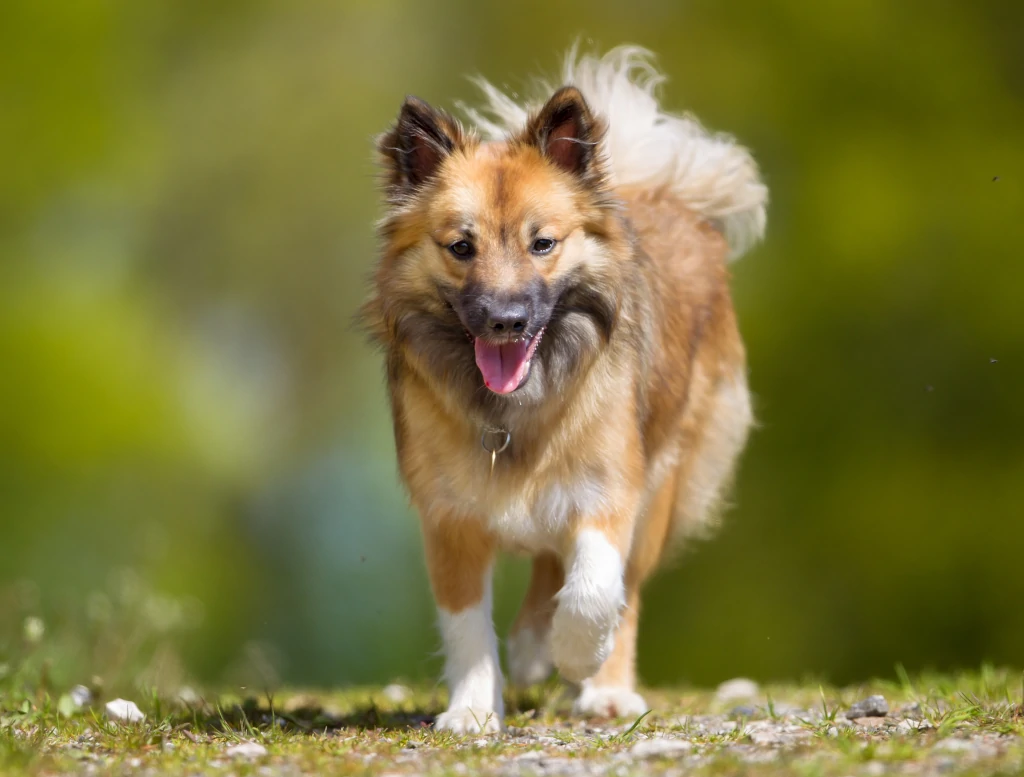
The Icelandic Sheepdog, with its vibrant personality and unmistakable silhouette, carries with it not just the tales of shepherding flocks in challenging terrains but also the echoes of Viking legacy.
Sailing through the pages of history, one discovers that the Icelandic Sheepdog’s journey began over a millennium ago, brought to the icy shores of Iceland by Viking settlers.
These dogs, essential to the survival of early Icelandic communities, were trusted guardians and herders of sheep, capable of navigating the country’s diverse and often treacherous terrains, from volcanic fields to icy fjords.
Physically, the Icelandic Sheepdog is a delightful blend of agility and sturdiness. Its medium-sized frame, covered in a dense double coat that can range from short to long and comes in a myriad of colors, is perfectly adapted to Iceland’s unpredictable weather.
Its pricked ears and curled tail, often reminiscent of its Spitz ancestors, are accompanied by expressive eyes that shimmer with mischief, intelligence, and warmth.
Delving deeper into its character, one finds a dog that is both lively and affectionate. Their cheerful barks and playful antics have endeared them to Icelanders for centuries.
Renowned for their herding prowess, characterized by their unique style of rounding up livestock with enthusiastic barks and quick movements, they remain indispensable to rural communities. Yet, it’s their endearing nature, their fondness for human companionship, and their innate sociability that make them cherished family members.
Training the Icelandic Sheepdog is a venture filled with joy. Their eagerness to please, paired with their intelligence, makes them highly trainable. However, their energetic disposition means they thrive best when given tasks or engaging in activities, be it herding, agility, or even simple games of fetch.
Today, the Icelandic Sheepdog stands as a proud emblem of Iceland’s rich heritage. Beyond its shepherding duties, it has emerged as a symbol of Icelandic culture and history, participating in parades and even being recognized in Icelandic literature and folklore.
19. Australian Kelpie: Master of the Outback
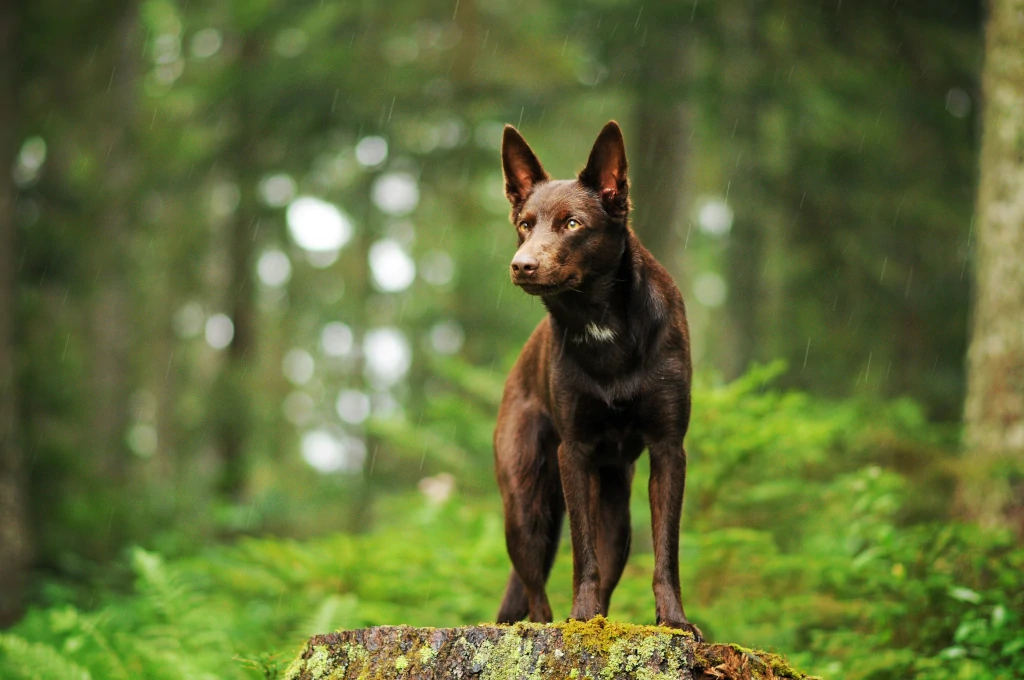
The Australian Kelpie, a breed defined by its agility, intelligence, and sheer determination, is the unsung hero of the vast cattle stations, bridging the gap between man and beast in the quest to conquer the outback.
The Kelpie’s history is as rich as the terrains it dominates. Believed to have descended from Scottish collies and other herding breeds brought to Australia in the 19th century, the Kelpie was sculpted by the demands of its environment.
As ranchers needed a reliable partner to manage vast herds across expansive properties, the Kelpie evolved, honing its skills and adapting to the unique challenges presented by the Australian landscape.
Visually, the Kelpie is a picture of elegance and efficiency. Its medium-sized frame, streamlined yet muscular, is built for speed and stamina. The coat, ranging from red to deep black, is a protective layer against the elements, be it the scorching sun or the occasional rain shower. Its piercing eyes, always alert, are windows to a world of intelligence and intuition.
But to truly understand a Kelpie, one must witness it in action. On the field, it transforms into a symphony of movement and control.
The breed possesses a natural herding instinct, corralling livestock with grace and precision. Its energy seems boundless, its focus unshakeable. With little more than a gesture or command, a Kelpie can control the flow of a herd, anticipate challenges, and adapt to changing circumstances.
Training an Australian Kelpie is a testament to its intelligence and eagerness to please. While they pick up commands swiftly, they are also thinkers, often using their initiative to solve problems. This independence and their work ethic make them invaluable assets on farms and ranches.
Beyond the pastures, the Kelpie has also made its mark in various canine disciplines, from agility to obedience, further showcasing its versatility and adaptability.
In the grand tapestry of dog breeds, the Australian Kelpie stands out not just for its abilities but for its spirit. A true representation of the Australian outback, the Kelpie is a testament to what can be achieved when nature, nurture, and necessity come together.
20. Puli: The Hungarian Curly Sentinel
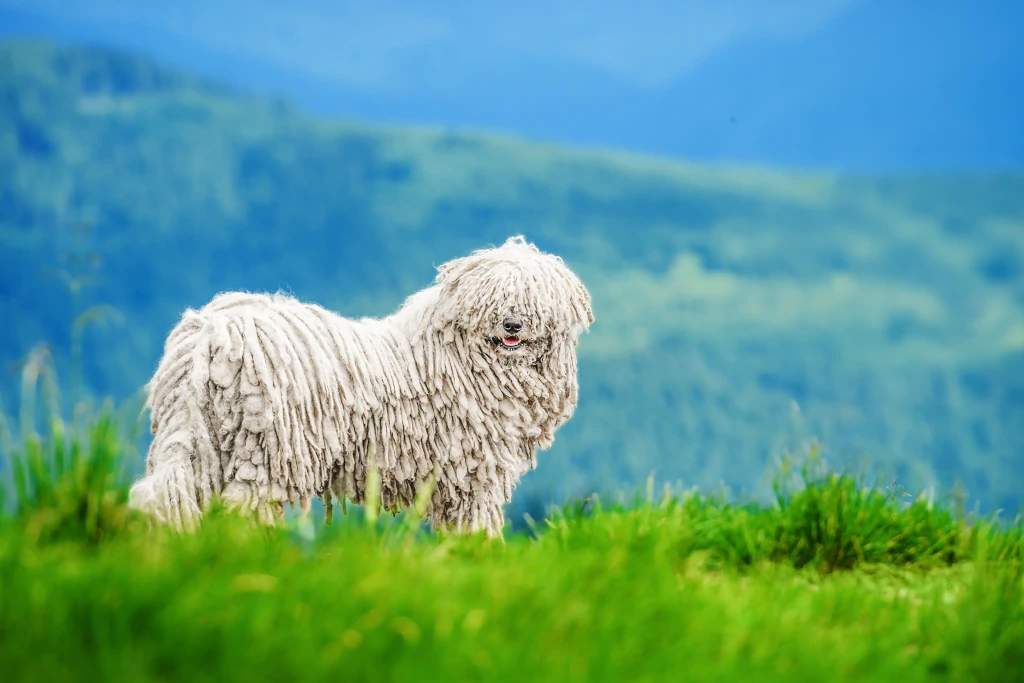
Step into the picturesque landscapes of Hungary, where rolling meadows meet historical landmarks, and you might chance upon a unique, almost otherworldly sight: a dog that seems to be draped in thick, corded ‘ropes.’ This is the Puli, a breed that seamlessly merges form with function, turning heads with its distinctive appearance while impressing with its herding prowess.
The Puli’s story begins in the Great Hungarian Plain over a thousand years ago. Brought to the region by Magyar tribes, these dogs were carefully bred for their working abilities. The Puli was more than just a herder; it was a guardian, a companion, and an integral part of pastoral life.
It’s impossible to discuss the Puli without delving into its iconic coat. Those characteristic cords often likened to dreadlocks or even mops, are not just for show. They serve as insulation, protecting the Puli from the elements, be it the harsh sun or biting cold. This unique coat, which can vary from wavy to tightly coiled cords, also offers protection from predators and rough terrains.
But beneath this shaggy exterior lies a heart of gold and a mind as sharp as a tack.
The Puli is renowned for its intelligence, agility, and tenacity. On the field, it’s a force to be reckoned with, guiding livestock with a harmonious blend of determination and care. The Puli’s nimble footwork and keen sense of awareness make it an adept herder, capable of making split-second decisions to keep its charges safe.
Training a Puli reveals its enthusiastic and sometimes stubborn nature. Quick to learn but with a mind of its own, the Puli thrives in environments that offer mental stimulation and physical challenges. This makes them exceptional competitors in dog sports like agility, obedience, and, of course, herding trials.
The Puli’s character extends beyond work. As a companion, it’s loyal, affectionate, and often comical. Their spirited antics and playful demeanor have endeared them to many, cementing their status as cherished family members.
Conclusion
In the vast realm of canine diversity, shepherd dogs emerge as an ode to human ingenuity and nature’s adaptability.
From the iconic silhouettes of the German Shepherd to the mop-like tendrils of the Puli, each breed narrates a tale steeped in history, culture, and purpose.
These dogs have not just been silent witnesses to the evolution of pastoral and urban societies; they have been active participants, shaping and being shaped by the demands and affections of their human counterparts.
Every shepherd breed, with its unique attributes and quirks, serves as a testament to the symbiotic relationship between humans and dogs. They’ve guarded our livestock, kept us company, and, in modern times, have taken on roles beyond the pastures, showcasing their versatility in canine sports, therapy, and companionship.
In embracing these breeds, we don’t just welcome a pet into our homes; we usher in a legacy of ages, a blend of nature’s finest traits honed by human touch.
Their loyalty, intelligence, and relentless spirit mirror the best aspects of humanity, reminding us of our roots and the age-old bonds that tie us to the animal kingdom.
Types Of Shepherd Dogs FAQ
Q1. What is the most popular shepherd dog?
A: The German Shepherd is widely regarded as the most popular shepherd dog. Recognized for its intelligence, versatility, and loyalty, it’s frequently used in police, military, and service roles, in addition to being a beloved family pet.
Q2. Which dog breed looks like a German Shepherd but smaller?
A: The Belgian Malinois, one of the Belgian Shepherd varieties, often resembles a German Shepherd but is generally more compact and lighter in build.
Q3. What is the smallest shepherd dog breed?
A: The Pembroke and Cardigan Welsh Corgis are among the smallest herding breeds. While not typically referred to as “shepherds,” they were historically used to herd cattle and have many of the characteristics of larger shepherd breeds in a compact package.
Q4. What is the largest shepherd dog breed?
A: The Caucasian Shepherd (or Caucasian Ovcharka) is one of the largest shepherd breeds. Originating from the Caucasus Mountains, these dogs were historically used to protect livestock from predators and can weigh well over 150 pounds when fully grown.
Q5. What are shepherd dogs primarily bred for?
A: Shepherd dogs, as the name suggests, were primarily bred for herding and guarding livestock. Their natural instincts, intelligence, and physical attributes made them perfect companions for farmers and pastoral communities.
Q6. Can shepherd dogs adapt to city living?
A: Yes, many shepherd breeds can adapt to city living provided they get adequate exercise and mental stimulation. However, potential owners should research specific breeds to ensure their energy levels and needs match the environment they’ll live in.
Q7. Do shepherd dog breeds require a lot of training?
A: Shepherd dogs are among the most intelligent canine breeds. While they often pick up commands swiftly, consistent training from a young age is crucial. Their keen intellect means they benefit from ongoing mental stimulation and challenges.
Q8. Are shepherd dogs good with children and other pets?
A: While every individual dog has its temperament, many shepherd breeds are known for their loyalty and protective nature, making them excellent family pets. However, due to their herding instincts, they might try to herd children or other pets. Proper socialization and training can mitigate this behavior.
Q9. How much exercise do shepherd dogs need?
A: Shepherd dogs are active and energetic. They typically require an hour to two hours of vigorous exercise to keep them mentally and physically fit. Activities like running, playing fetch, or agility training are beneficial.
Q10. Are shepherd dogs suitable for first-time dog owners?
A: Some shepherd breeds can be a handful for first-time dog owners due to their high intelligence, energy levels, and specific training needs. However, with commitment, proper research, and perhaps the help of a professional trainer, many new owners find joy and companionship in shepherd dogs.

